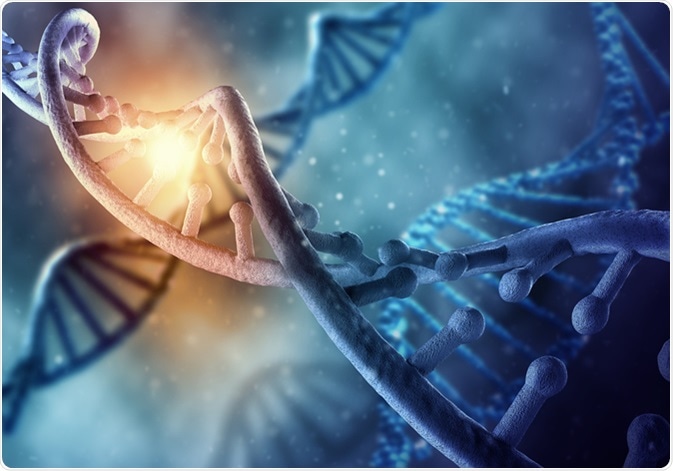Autism spectrum disorder (ASD) is a cluster of neurodevelopmental diseases in which genetic changes play a large part. It affects about 1 in 160 people and typically manifests between one and three years of age, with complex communication and interpersonal interaction deficits which lead to difficulties in relating to the world.
Autism is categorized into two subgroups those who have no other associated disorder and those who do. It is called essential autism when it is not associated with any other disorder, which is found in 75% of cases and the remaining patients have syndromic type autism.

Image Credit: ESB Professional / Shutterstock
Diversity of DNA Mutations
A large variety of DNA alterations have been detected in ASD patients, which are different from patient to patient. They include aneuploidy or structural rearrangements of the chromosomes detected by karyotyping, single gene mutations and genomic disorders. Single gene mutations include single nucleotide variants (SNV) and single nucleotide polymorphisms (SNPS), which are mutations of rare genes and common variations, respectively. They are detected by gene sequencing techniques. Genomic disorders include copy number variants (CNVs) and structural variations (SVs) which require advanced genomic profiling such as next-generation sequencing and microarrays. These are the most common genetic disorders associated with autism, found in 10-35% of cases. Syndromic genetic variants account for about 10%.
No gene disorder associated with ASD has been found in over 1% of affected individuals, which means that anywhere from 300 to 1000 genes have been linked to this disorder. About a third of ASD is due to de novo mutations, but the remaining risk is now explained at least partially by the occurrence of rare inherited variants in noncoding DNA sequences.
Noncoding DNA Variants
One intriguing finding of current research is that the noncoding part of the DNA, known as junk DNA, contributes to the disease by mutations that alter the regulation of transcription of coding segments. It is already known that epigenetic changes such as DNA methylation occur with environmental alterations and thus transfer the influence of a person’s environment to the offspring in a heritable way, known as transgenerational epigenetics. All these may well be part of the disease process in autism.
In addition to mutations of genes, the inheritance of changes in noncoding DNA or junk DNA is also a key player in this game. Almost 98% of the DNA in humans is apparently noncoding, but it is far from useless because it comprises of regulatory elements that switch genes on or off, regulate transcription and may have numerous other roles as well.
These noncoding DNA variants may be in the form of duplications or deletions. They do not alter the function of the genes nor do they change gene structure. What they do result in is a disruption of various control elements that are responsible for gene transcription regulation, also called cis-regulatory elements or CREs. They are even more interesting because unlike the de novo mutations responsible for a third of autism, and which occur in the coding genes that comprise 2% of the genome, these are inherited from the parents and occur in the remaining 98% of DNA.
Importance of Parent-of-Origin Genes
A new discovery in this area is that mutations in noncoding DNA sequences that increase the risk of autism were inherited from fathers, while the gene mutations that confer autism risk are found in maternally inherited sequences. Thus the father and mother contribute in different ways to the development of autism in the offspring.
These findings are derived from genomic analysis in more than 9000 subjects culled from 2600 families. Many teams have been involved, including the University of San Diego, private laboratories in San Diego, and other genomic sequencing projects. Sequencing and analysis of DNA is now done using supercomputers, followed by analysis of SVs that disrupt CREs (CRE-SVs).
Comparing genomes within families, these CRE-SVs passed down from parents are found to be involved in the pathogenesis of ASD. Surprisingly, they are mostly inherited from fathers, while gene mutations which are involved in autism etiology involve genes of maternal origin. This could possibly be explained if coding variants are different in their effects from noncoding variants. The weaker nature of changes in noncoding variants could lead to their better toleration than the stronger effects due to coding variants. Moreover, male and female biology may be geared differently, leading to better tolerance of these variants in either males or females. This might be one reason why junk DNA mutations are sensitive to the parent of origin in inducing autism.
Autism and Genetics
Conclusion
Although research has been challenged by the complexity of the expansive genetic variations associated with ASD, with variations only being shared in a very small proportion of patients, more recent developments have shown promise of more continuity between ASD sufferers. This includes de novo mutations, which are common in one third of ASD cases and more recently the discovery of the association of mutations and inheritable variants in junk DNA.
Further Reading